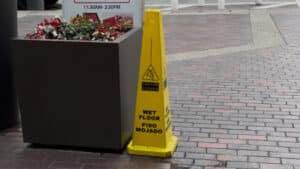Handrails continued: In addition to the requirements identified last week concerning the size and placement of handrails on staircases, requirements exist relating to the height off of the stair tread, the weight loads the handrails must bear, and how far the handrails must extend beyond the first and last step. California Building Code (CBC) section 3214 requires that handrails be on both sides of staircases greater than 44 inches in width.
Stairways serving buildings with less than 50 individuals “the occupant load” shall have a width of not less than 36 inches. Stairways having less than four risers need not have handrails or stair railings. Stair rails should be installed such that there are have a vertical height between 34 and 38 inches above the nosing of treads and landings. For stairs installed before April 3, 1997, the height shall be between 30 and 38 inches. Stair railings and handrails must be continuous, the full length of the stairs and, except for private stairways, at least one handrail or stair railing shall extend in the direction of the stair run not less than 12 inches beyond the top riser nor less than 12 inches beyond the bottom riser.
The ends of these stair rails must be returned to the wall or terminate in newel posts.
The handrails need to be mounted such that they are capable of withstanding a load of at least 200 pounds applied in any direction at any point on the rail.Stair height and depth: CBC 1009.4.2 states that stair riser heights (the vertical distance from tread to tread) shall be 7 inches (178 mm) maximum and 4 inches minimum. The riser height shall be measured vertically between the leading edges of adjacent treads. Rectangular tread depths (the flat walking surface) shall be 11 inches minimum measured horizontally between the vertical planes of the foremost projection of adjacent treads and at a right angle to the tread’s leading edge.
Pursuant to section 1000 9.4.4 the stair treads and risers on a flight of stairs must be of uniform size and shape allowing only for a 3/8 inch deviation. A minimum of 6 feet, 8 inches of headroom, is required at all landings.Stairway landings: CBC 1009.5 requires floors or landings at the top and bottom of each stairway have a width not less than the width of the stairways they serve. Each landing shall have a minimum dimension, in the direction of travel, equal to the width of the stairway. A door opening onto a landing can’t reduce the landing to less than one half the required width.Stairway markings: CBC 3306(r) requires that the upper approach and the lower tread of each stair shall be marked by a strip of clearly contrasting color at least 2 inches wide placed parallel to and not more than 1 inch from the nose of the step or landing to alert the visually impaired. The strip shall be of a material that is as least as slip-resistant as the other treads of the stair. If the stair is outside of the building, the same dimensions apply however, the strip must be made of a slip resistant material.So, Marissa, take photographs of the stairway where you fell.
Put a ruler in the picture to show the rise (height) and run (width) and make sure that the stair height and width are uniform along the entire length of the staircase. Take pictures of the handrail, the condition of the stairs, the height of the rail off of the tread surface, the end of the handrail (to see if it ties back into the wall) and the top and lower tread (to demonstrate whether there is a visual break by contrasting color of at least 2 inches wide). Then take these photographs to a trial lawyer who can review them to see if there is a case of liability against the landlord for failure to maintain a stairway within the safety requirements of the building code. For all you landlord’s out there, check your staircases, it’s better to be safe then sued!
Contact A Slip And Fall/Premises Liability Attorney At The Dolan Law Firm Today
If you have been injured in a serious slip and fall accident, contact our attorneys today by completing our contact form or call us toll free at 1-888-452-4752 for skilled and experienced legal counsel. We will review your case for free, promptly and with no obligation on your part.
We serve clients across the San Francisco Bay Area and California from our offices in San Francisco and Oakland. Our work is no recovery, no free or also referred to as contingency-based. That means we collect no fee unless we obtain money for your damages and injuries.










